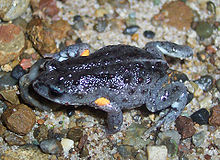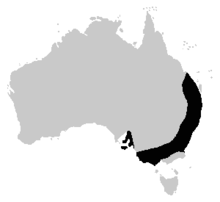- Bibron's Toadlet
-
Bibron's Toadlet 
Conservation status Scientific classification Kingdom: Animalia Phylum: Chordata Class: Amphibia Order: Anura Family: Myobatrachidae Genus: Pseudophryne Species: P. bibronii Binomial name Pseudophryne bibronii
Günther, 1859
Range of the Bibron's Toadlet The Bibron's Toadlet or Brown Toadlet, (Pseudophryne bibronii) is a species of Australian ground-dwelling frog, that although has declined over much of its range, is widespread through most of New South Wales, Victoria, south-eastern Queensland and eastern South Australia, including Kangaroo Island.
Contents
Physical description
This species is variable and may represent more than one species. It grows to about 30mm in length and is brown, grey or black above, often with scattered red spots. It is normally strongly marbled black and white on the ventral surface, however in some areas this marbling can be faint. There is always an orange, red or yellow patch in the armpits. This patch varies from yellow to orange between sites. At the Jervis Bay region this patch is always yellow, this may be a result of hybridisation with the Southern Toadlet (Pseudophryne dendyi) which has a strong yellow patch in the armpits. There is also a yellow/orange patch or raised bump on the back of the thigh.
Behaviour and ecology
This species inhabits areas that are likely to be inundated after rain. This can be anything from coastal swamps, creeks, temporary ponds/roadside ditches in forest, cleared land, heathland and even sub-alpine areas. When threatened, the Bibron's Toadlet will often lie on its back, unresponsive, pretending to be dead. This performance had been reported to last for up to an hour.
Reproduction
The males attract the females by making a grating "ark" noise from a concealed area, in mud, under rocks or damp leaf litter. They normally call after heavy rain or when water is available, they call all year round but normally from February to June at temperatures as low as 4 °C (39 °F).
The species is polyandrous, with each female mating with several males. The female visits up to eight males, mates with each, and deposits eggs in the shallow nest he has dug.[1][2] The female moves on and the male tends the nest. The nest, which may contain moist leaf litter or sphagnum moss, floods during rain. The eggs hatch and the tadpoles develop in the water. If no sufficient rain happens soon after laying the eggs can remain unhatched for many weeks, with the tadpoles developing inside. The nest must stay wet so the eggs remain moist, but not too wet or they will be washed away. Female frogs that mate with more males, thus depositing eggs in more nest sites, are more likely to have some young survive.[1]
Sources
- Anstis, M. 2002. Tadpoles of South-eastern Australia. Reed New Holland: Sydney.
- Robinson, M. 2002. A Field Guide to Frogs of Australia. Australian Museum/Reed New Holland: Sydney.
- Frogs Australia Network-frog call available here.
- SA EPA's Frogs of South Australia website
References
- ^ a b Ehrenberg, R. Female frogs play the field. Science News 174:8. October 11, 2008.
- ^ http://www.sciencedaily.com/releases/2008/09/080918091335.htm
- Gillespie et al. (2004). Pseudophryne bibronii. 2006. IUCN Red List of Threatened Species. IUCN 2006. www.iucnredlist.org. Retrieved on 11 May 2006. Database entry includes a range map and justification for why this species is near threatened
Categories:- IUCN Red List near threatened species
- Amphibians of Queensland
- Amphibians of New South Wales
- Amphibians of the Australian Capital Territory
- Amphibians of Victoria (Australia)
- Amphibians of South Australia
- Pseudophryne
- Toadlets
Wikimedia Foundation. 2010.

